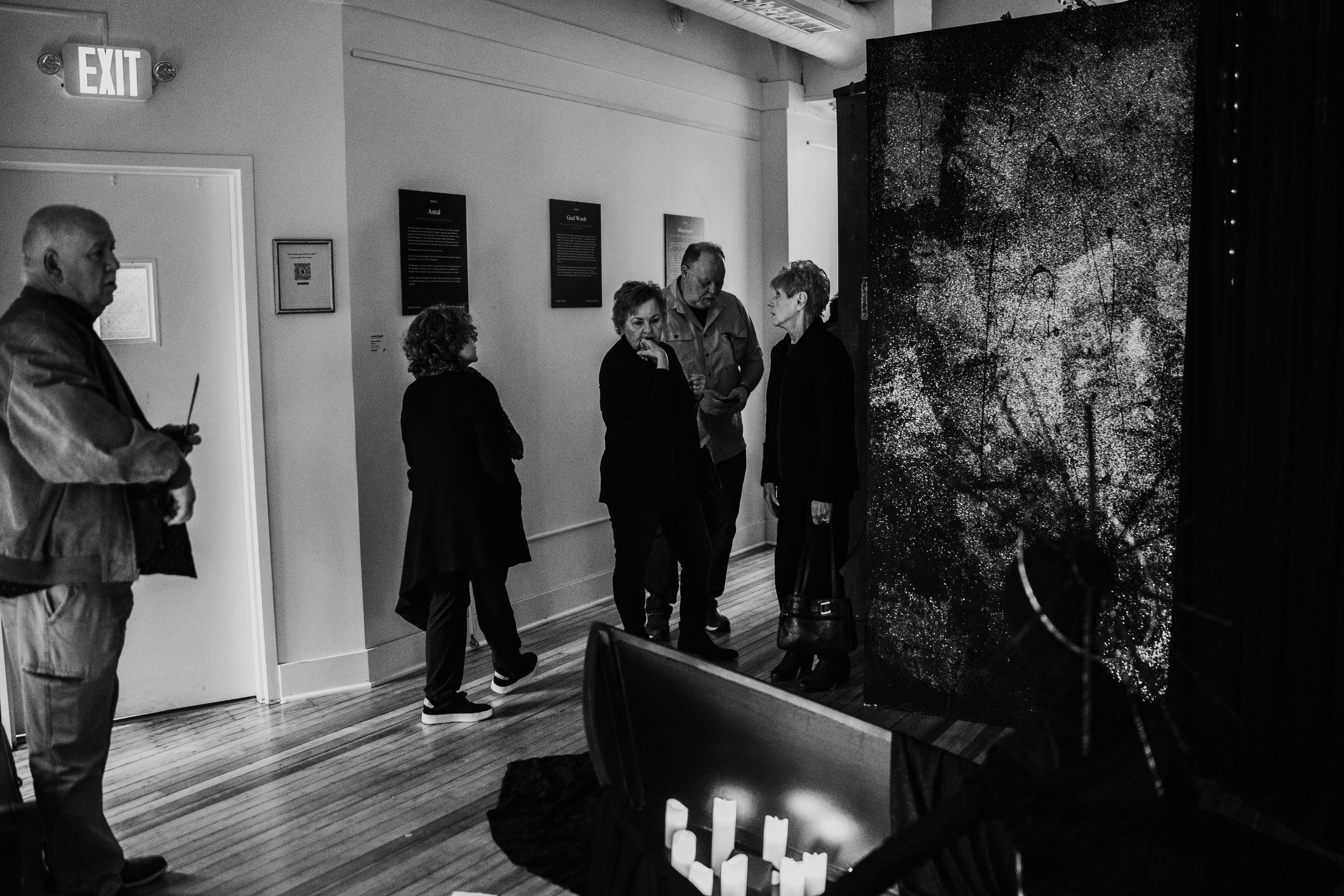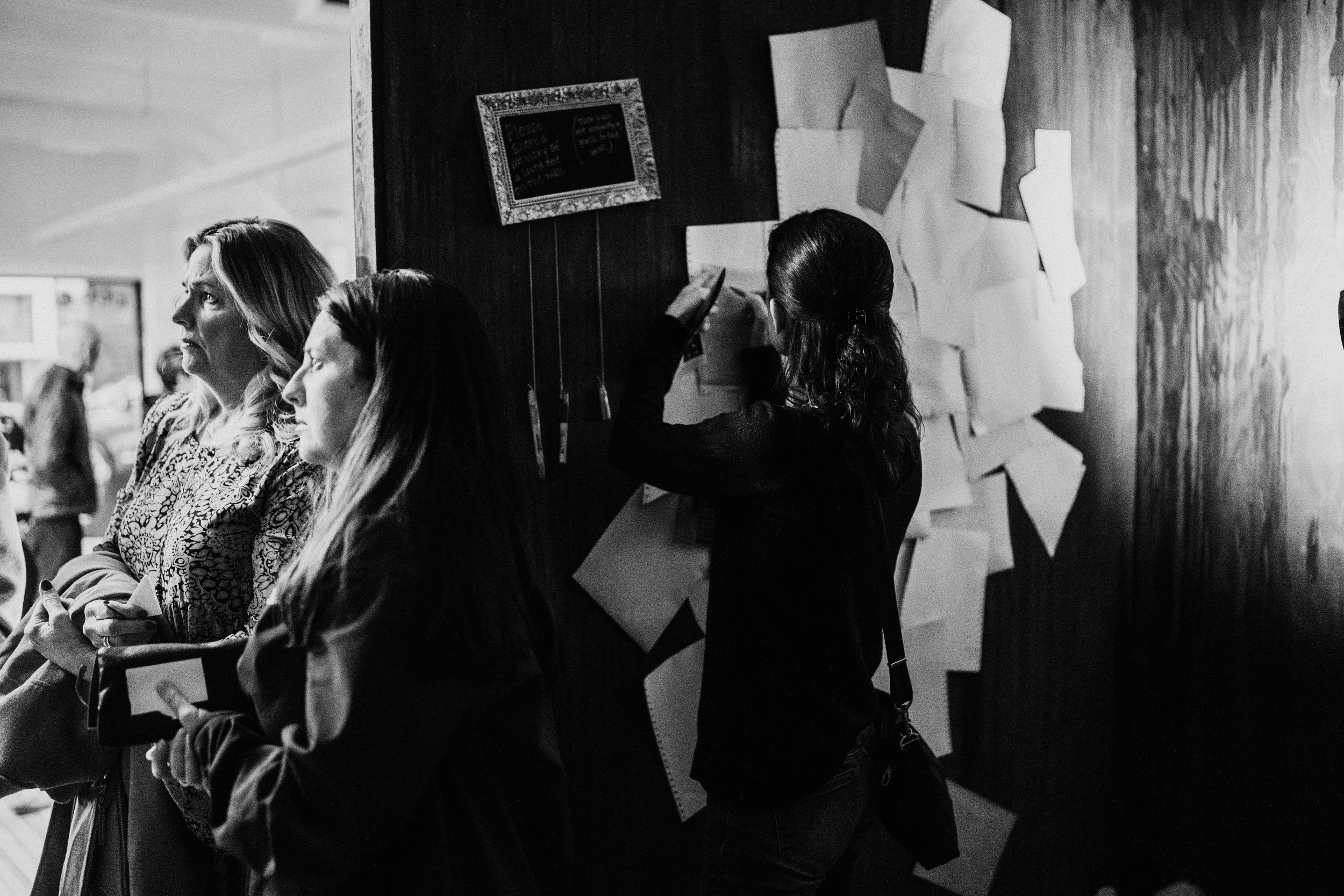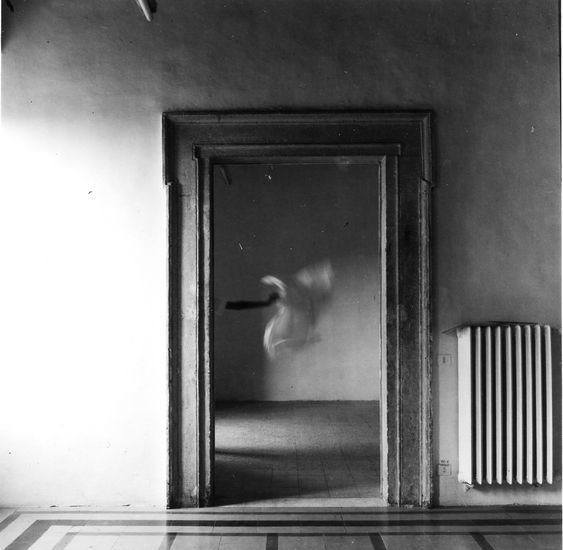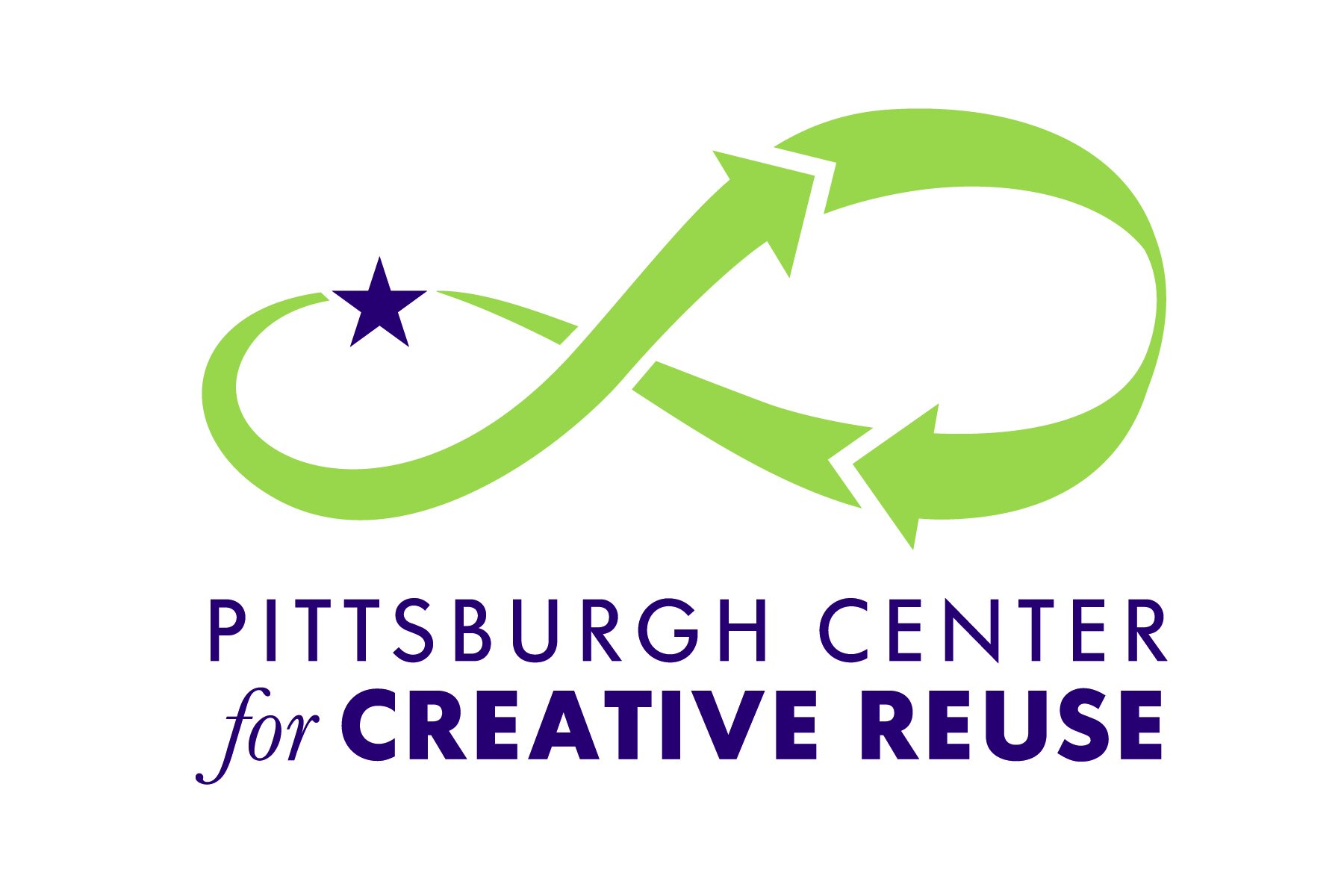THE REMEMBERING ROOM
THE REMEMBERING ROOM is a collection of poems and prose that explores the journey of grieving in hopes of reaching peace. Amanda Filippelli works through the process of becoming a parent while simultaneously losing one by opening her heart and allowing her grief to come to the surface. Through beautiful writing and a raw experience, Amanda takes us with her as she heals from the pain of loss into opening herself up to motherhood.
THE EXHIBIT
About the Exhibit
Last June, I was teaching a virtual writing course when my mom called and said that my dad never picked her up from work and that she wanted me to check
on him. Figuring he got caught up in one of his hobbies and forgot, I ended my class early and sped to their house, angry about the interruption. His car was in
the driveway - I could see that he’d been working on it that morning. The grass was freshly cut, and all the doors and windows in the house were left open. I trudged around the house, calling for my dad, looking in every room.
Silence.
And then a strange feeling came over me as I stood in the kitchen, wondering what was going on. A feeling that halted time. That made everything feel still and airless. I walked outside, and to my surprise, my dad was there, alone, in his chair on the porch. He was gone. He’d been gone for hours. He was only 61.
Two weeks after my dad passed away, I found out I was pregnant with my first child. And a year after that, to the day of my dad’s passing, I lost my dog of nearly fifteen years to the same disease that took my dad away. In a single year, my life had become so full of both grief and joy, of enormous loss and enormous gain, and I didn’t know how to feel about any of it anymore. Add to that the state of the world - the pandemic, the political and sociological eschewing of the fabricof our rights; our identity as a people, climate change, the economy, and our collective paranoia about where this spiral will leave us.
“Pittsburgh artist and writer Amanda Filippelli is shining light on a dark period in her life through a new art exhibit.”
- Pittsburgh Magazine
It’s all so much.
But as a creative, I truly believe - have to believe - that when we’re given this sort of front row seat to such life- changing feelings and experiences, that it’s our responsibility to channel them into something useful we can share. For me, all of this has birthed The Remembering Room. I think we need a collective space as a community where we can go to grieve and to work out the traumas of these past few years. Without doing this, how can we expect to move forward? How can we progress with fresh perspectives without first processing the grief and hurt and fear and loss we’re all feeling? The Remembering Room was spawned from a new book of poetry that explores the 4 different stages of grief I’ve worked through. I want to build The Remembering Room into a physical place that functions as an interactive installation where people can share their own experiences, can write inside and on the exhibit, can sit with the imagery and artifacts in the exhibit, can add their own artifacts if they choose to, and can spend the time they need to process their own grief.
The Exhibit premiered March 9th - April 16th, 2023. It was open and free to the public. The Remembering Room Exhibit appeared in Atithi Studios located in Pittsburgh, Pennsylvania.
“The Remembering Room merges Filippelli’s life-changing story with an exploratory and healing experience that fosters learning, growing and connecting in our own experiences of grief.”
-Littsburgh
GRIEF AND THE SURREAL
WHY THIS EXHIBIT IS SO IMPORTANT FOR ALL OF US
When the pain of grief is ripe, when it comes and surrounds you; when it chips away at the edges of this life - of your life, it comes with sparse moments of immense joy - of laughter amidst the absurdity. And not the absurdity of what
is but of what was - before death showed you the truth of everything. The pain of it all is the comfort - this porous thing full of anguish and laughter and love and despair, but most of all, surrender.
THE IMPORTANCE OF EXPERIENCING THE SURREAL
When our brains struggle to process a traumatic event, they tend to reach into the recesses of our pyche and create fantastical thoughts and perceptions. Sometimes these thoughts are difficult or disturbing, and sometimes they are revelatory. In both cases, it is this experience of the surreal that allows us to expand our understanding of our own existence whenever deep grief impacts us. The surreal is where interpretation thrives; where we go when words simply can’t capture meaning; where our interior experience expresses itself. Like deciphering a dream, the surreal nature of moving through grief asks us to decode our feelings about the thing we are grieving, in turn forcing us to learn more about ourselves and each other in the process. So while grief is a painful process, it is a necessary one - one that people so often try to avoid rather than traverse through. This exhibit aims to show people how traversing through the pain of grief also carries the opportunity for enormous growth, healing, hope, and connection. When we’re suffering, the surreal helps us define our emotions and, thus, our reality.
THE FOUR ROOMS
DESERT
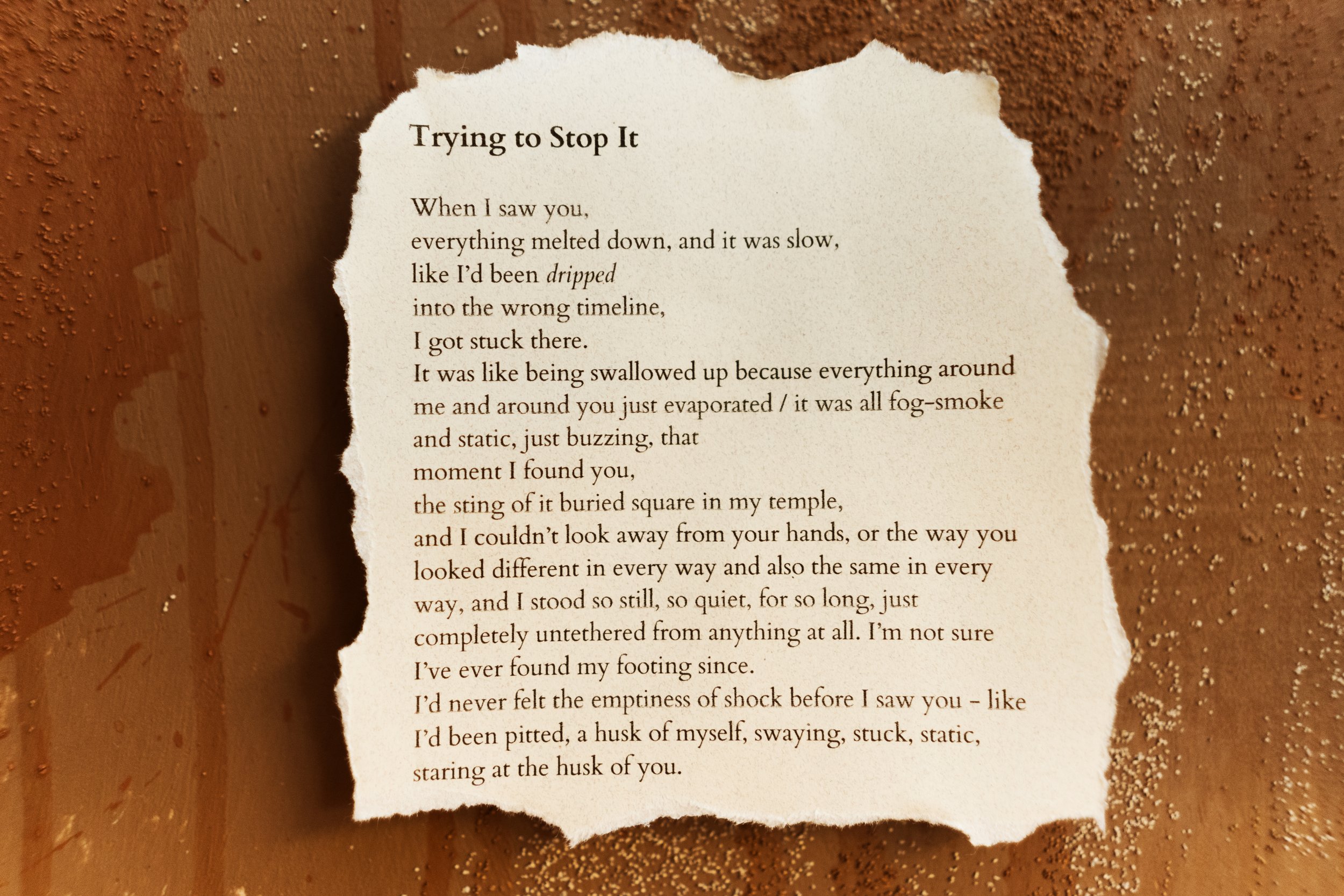
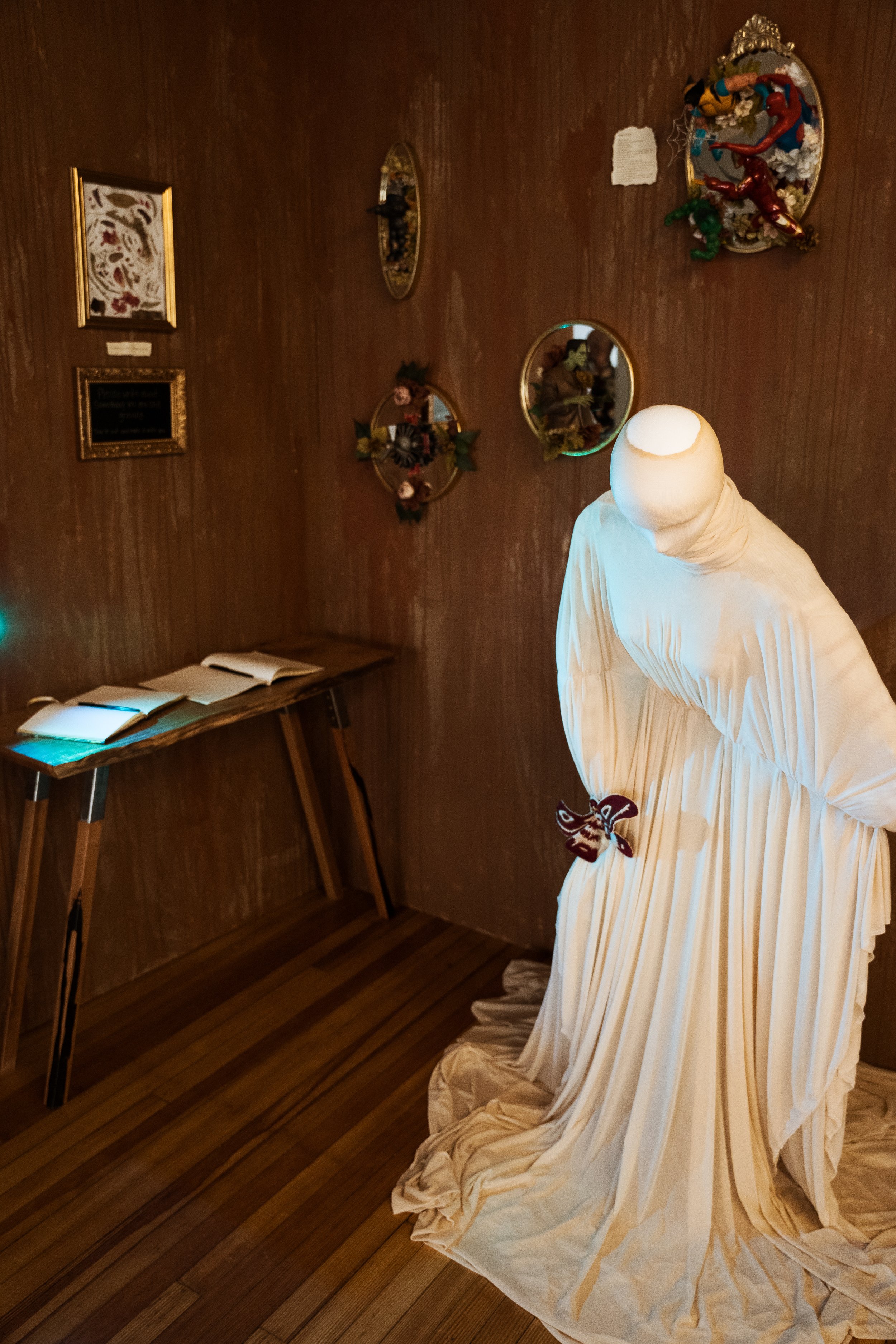
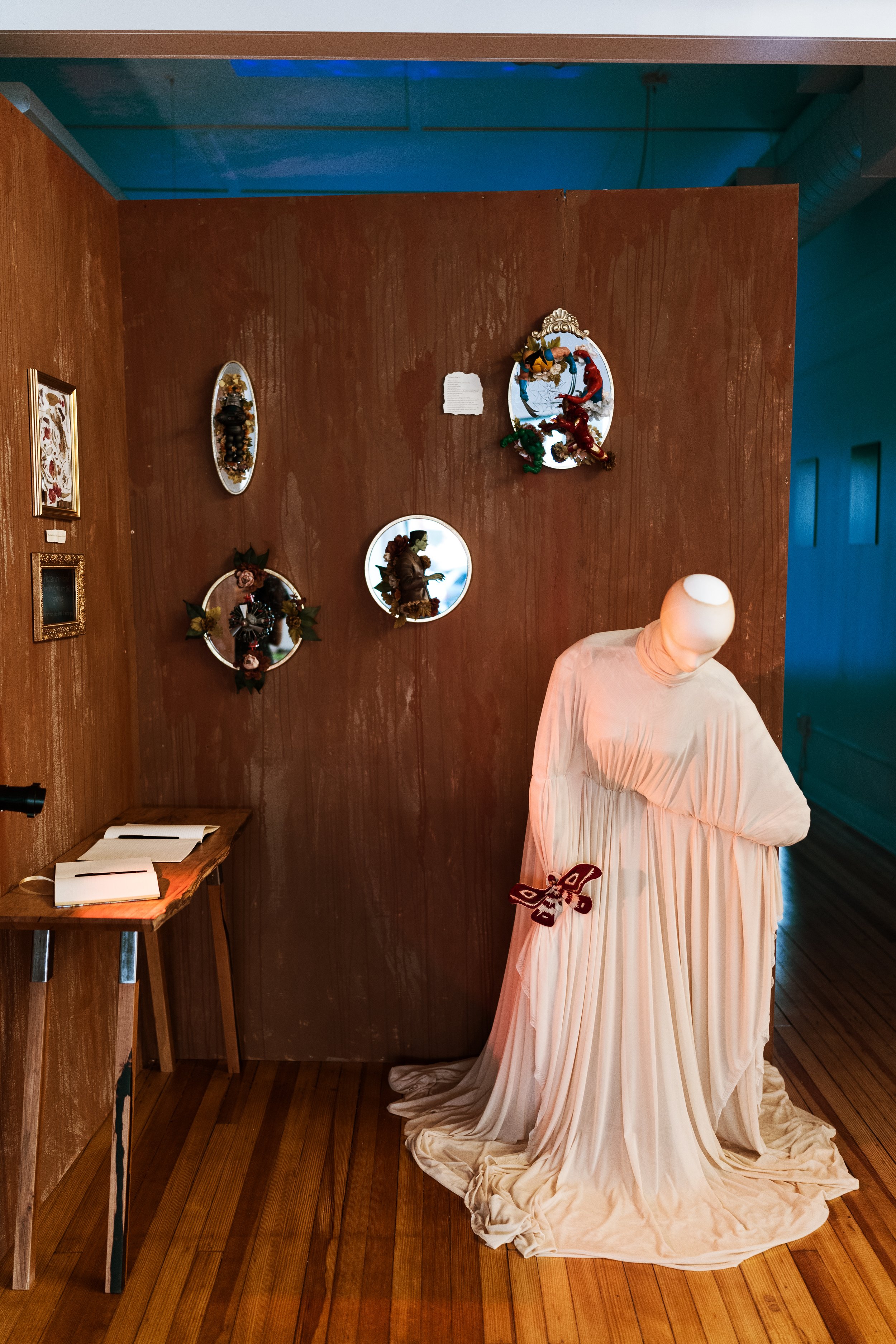
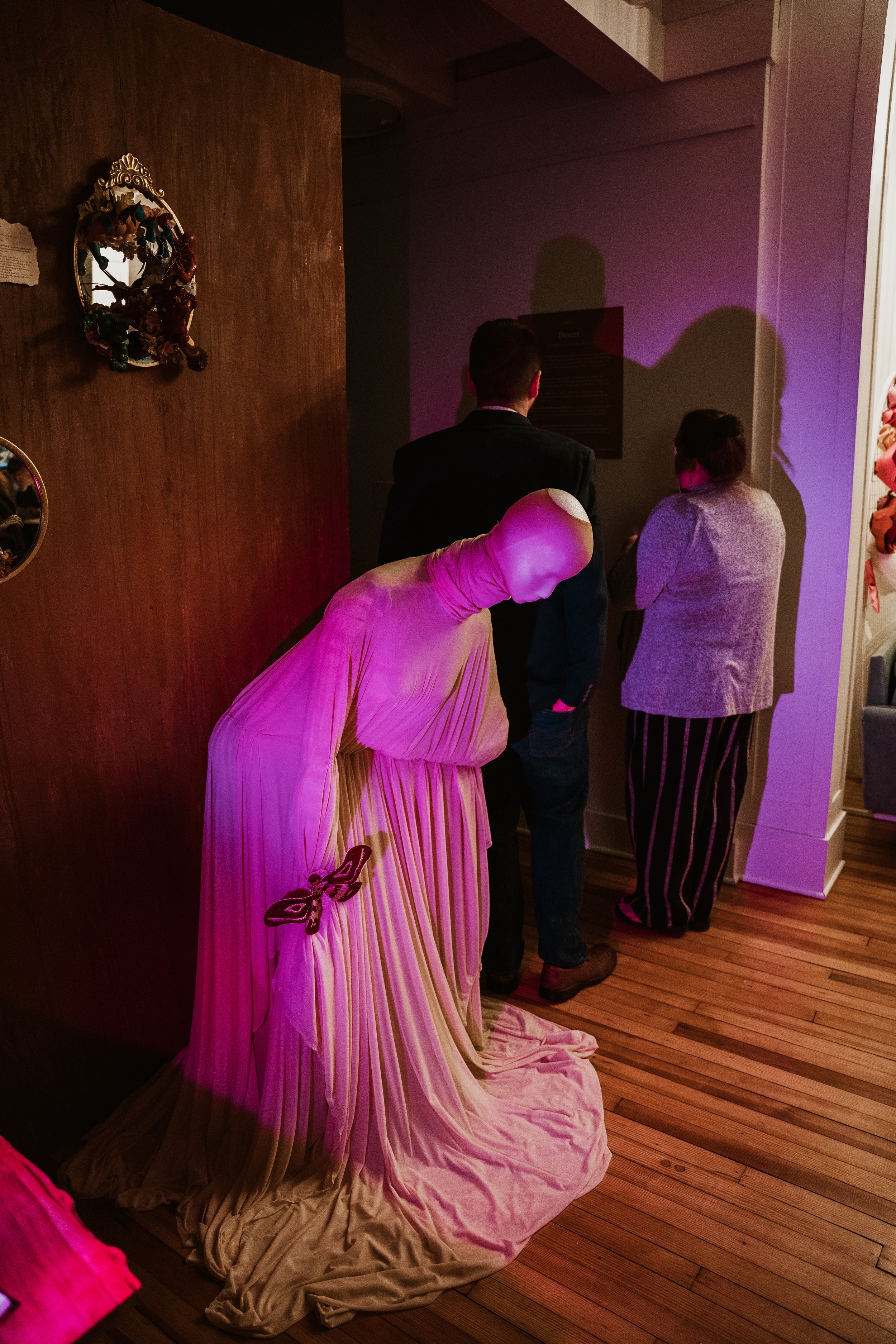

-
Everything in the world started to reverberate the moment I found my dad - the moment I physically saw death. Something changed inside of me on an atomic level at the sight of it. I remember hearing static, my mind going truly blank for the very first time, and then, unable to process the moment, thinking to myself, What am I looking at here? What is happening to me?
I stayed in that static for a long time, mentally wading through the trauma of the experience of that day, trying to piece together the difference between memories and dreams, vacillating between moments of a searing numbness and outbursts of deep pain.
The manneuqin in this room is trapped in a restrictive nylon garment that lacks openings for their limbs. Their head is encased in a wire headdress, buzzing with the static flap of moth’s wings.
This room is littered with surreal objects that are made from merged items that come from both memories and dreams - items half from this world and half from another; items that came to be in a time when grief had me teetering between the veil of this world and the next.
There is a writing desk in this room, full of handwritten poems, scraps, notes, scribbles. Visitors are able to sit at the desk and write in the journals provided, add to the writing they find there, and leave notes of their own - all of which will remain static in this cerebral and emotional desert.
MNEMOSYNE
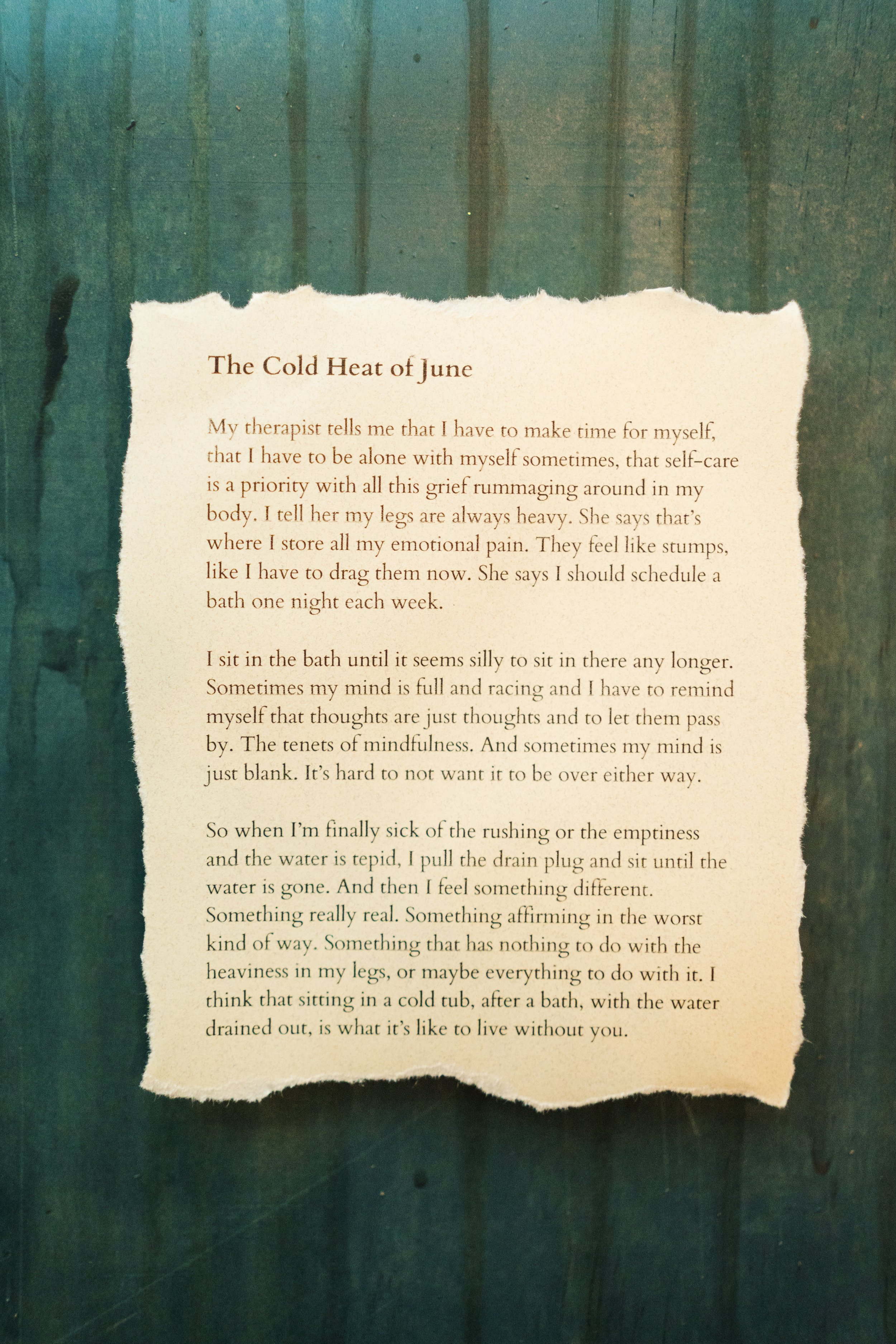
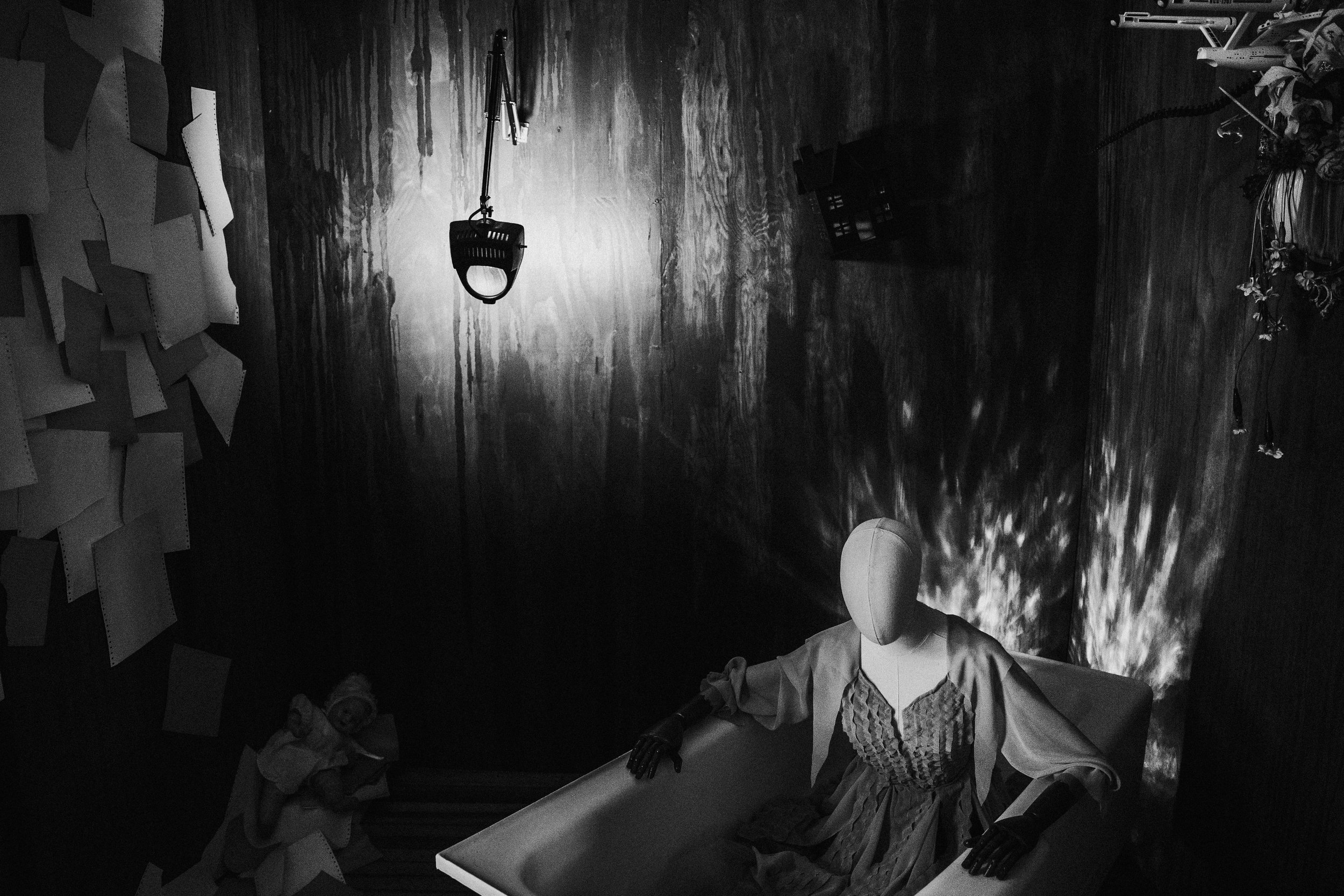
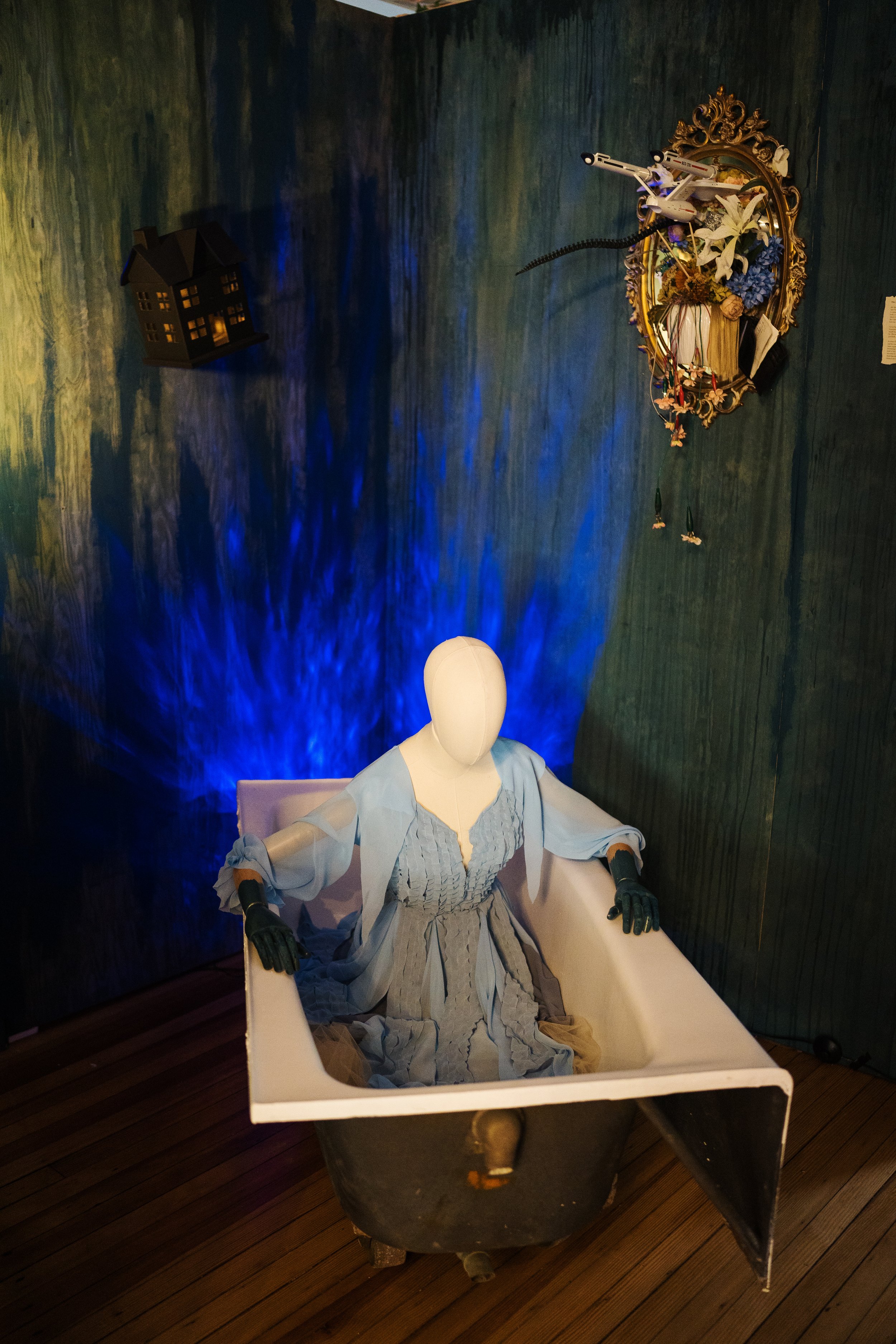
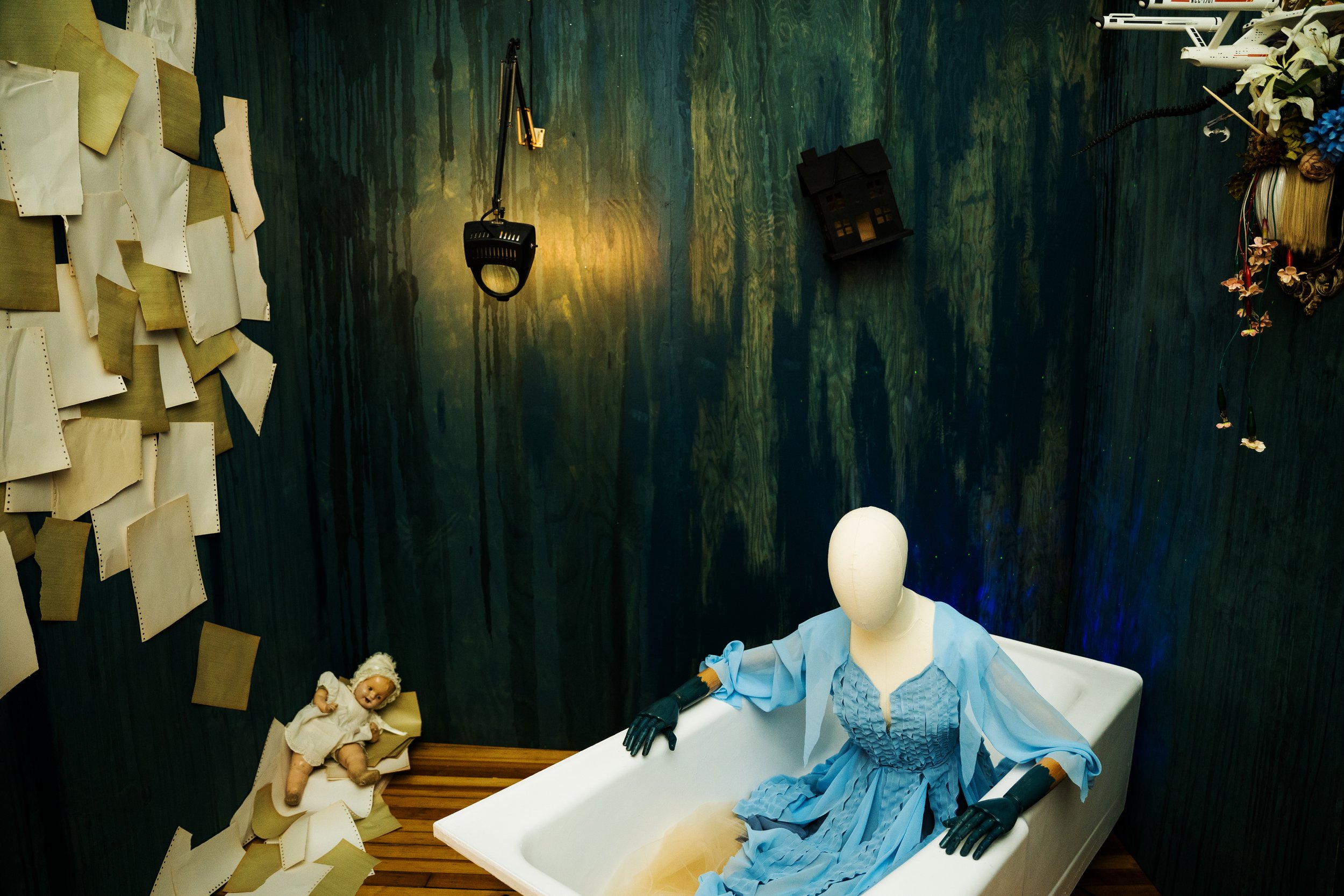
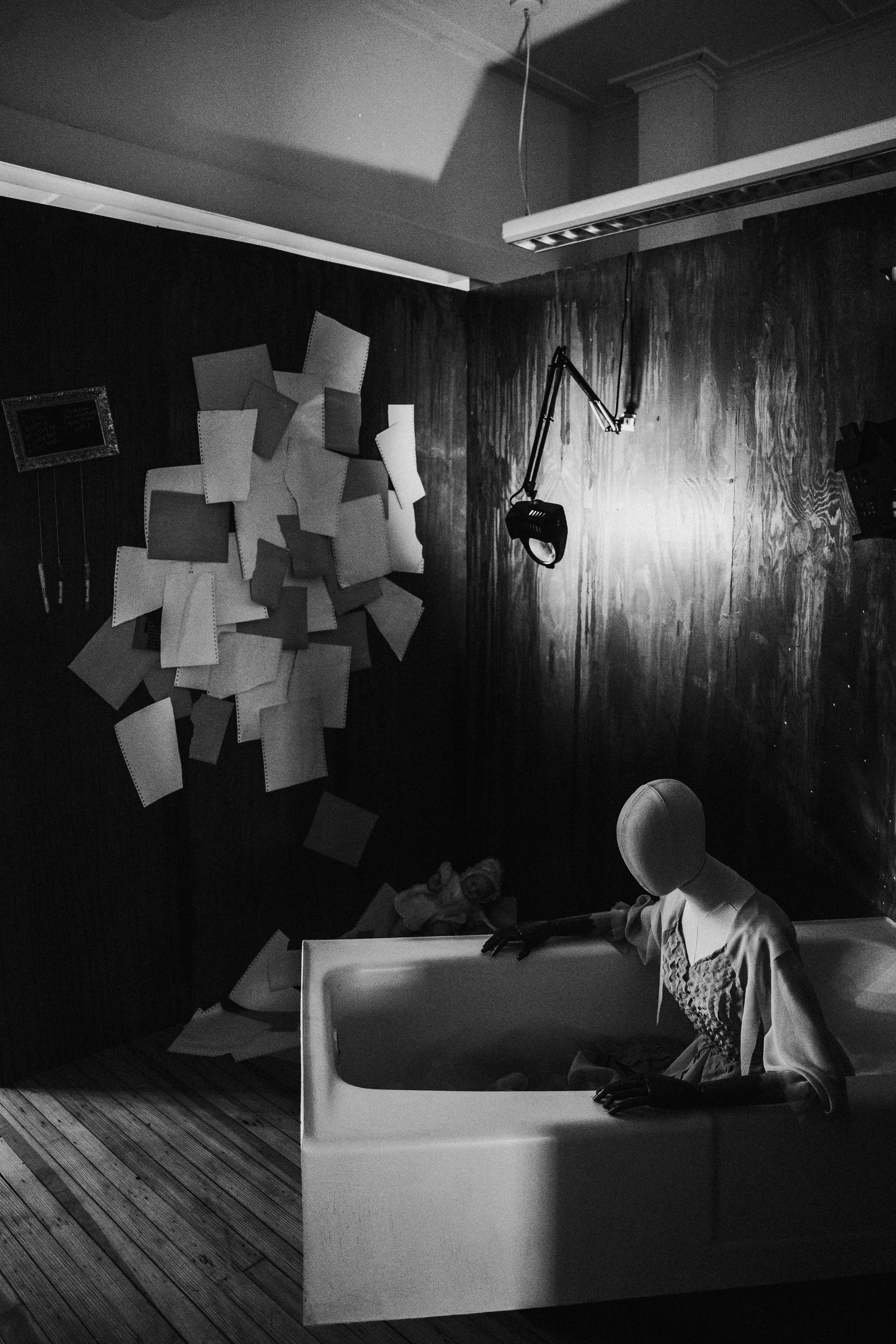
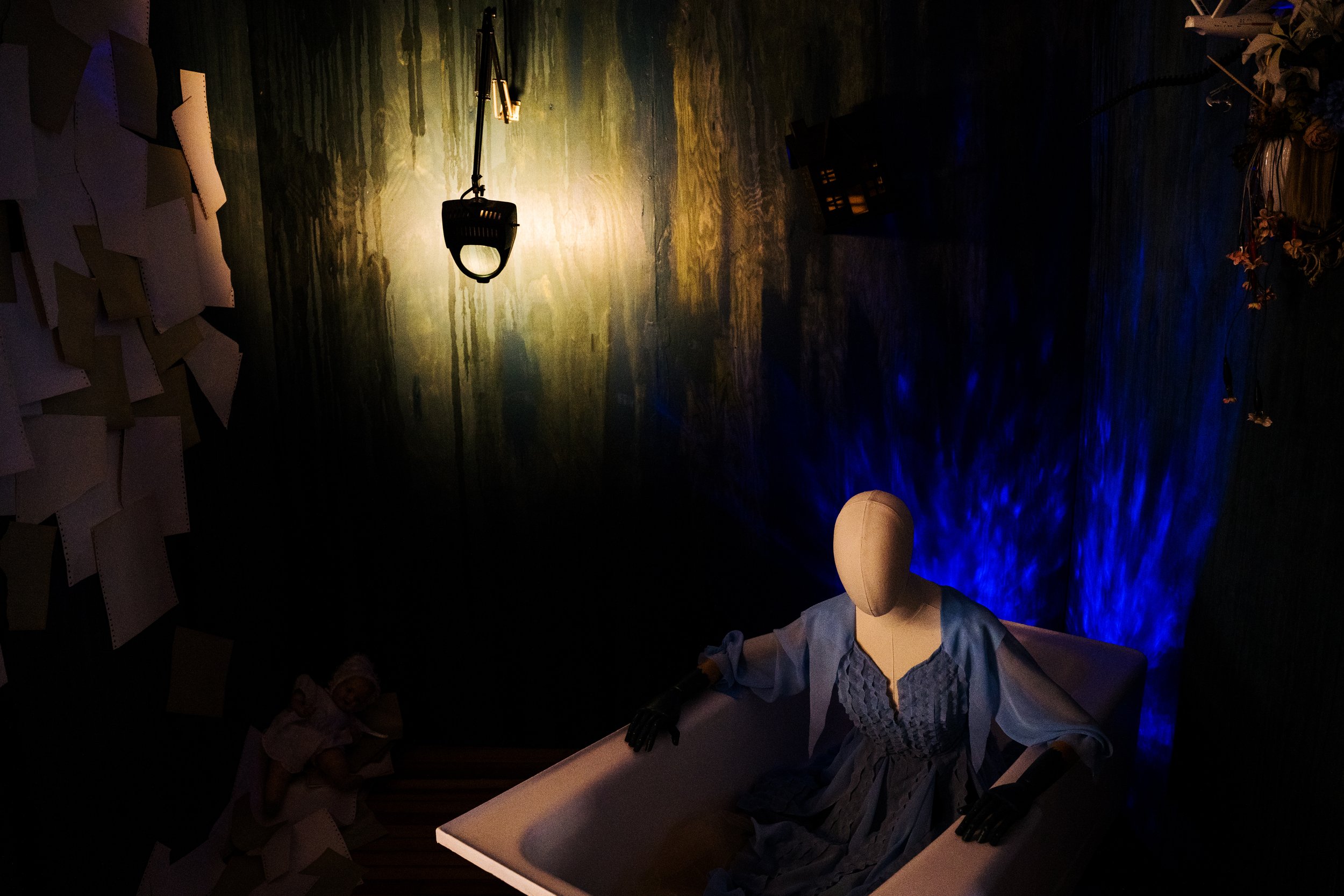
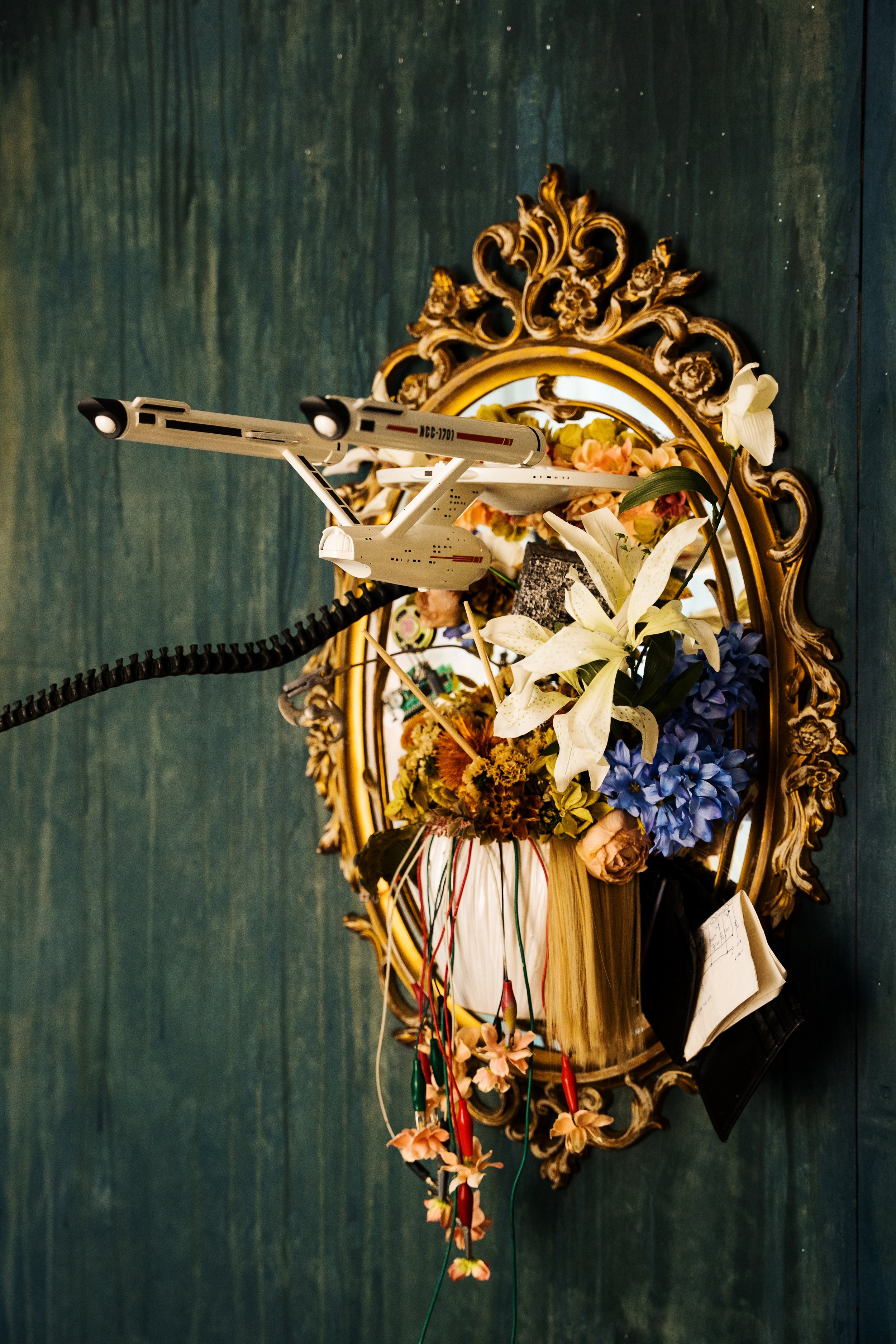



-
Once the static of grief dissipated, I was plunged into a deep ocean of memories. And of yearning. I lived in the past for a long time, trying to ascribe meaning to my father’s death.
I’ve always found bathrooms comforting in times of stress and anxiety, and I spent a lot of time huddled in my bathtub after my dad passed, parsing through my memories of him, reading a lot of physics and trying to dismantle the liminal and linear understanding of time, hoping to time travel in some way. But more than that, I was trying to conceive the inconceivable - eternity, the existence or nonexistence of life after death, and the death process itself. It gave me the same shivers I get when I think about an ever-expanding universe or an ocean deep enough that creatures writhe in ink black waters.
The mannequin in this room is draped in a sheer blue chiffon garment that symbolizes the thin veil between a body existing and not existing. They’ll be positioned in a bathtub with a false bottom that looks into a deep, darkening ocean - Mnemosyne’s ocean.
There will be a strong audio component in this room that is a mixed compilation of audio from home videos as well as poems from The Remembering Room being read. Visitors will be encouraged to explore this room while listening to the recording, to look into the bottom of the bathtub, and to write on a designated wall if they wish to.Description text goes here
GRIEF WOMB
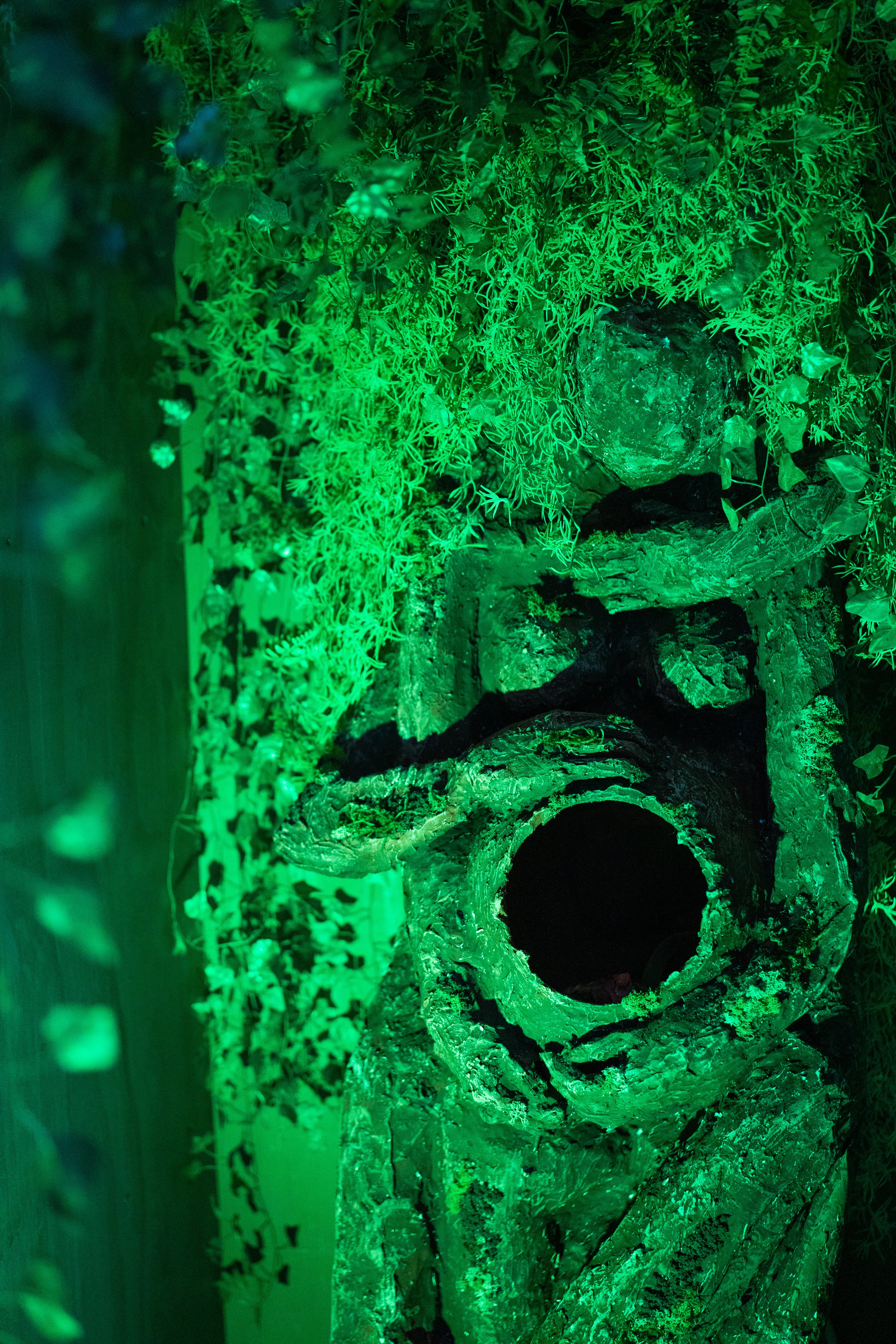
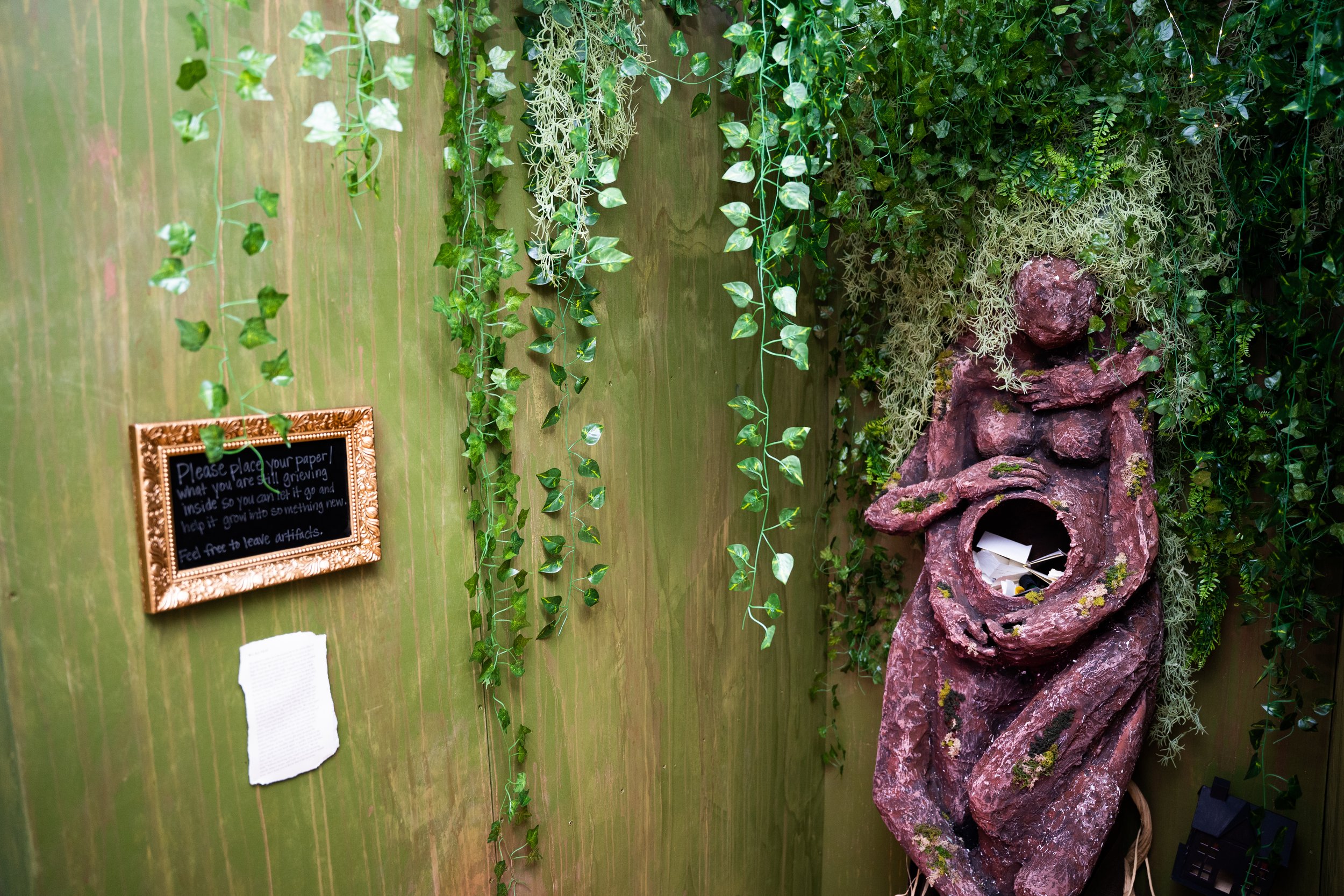

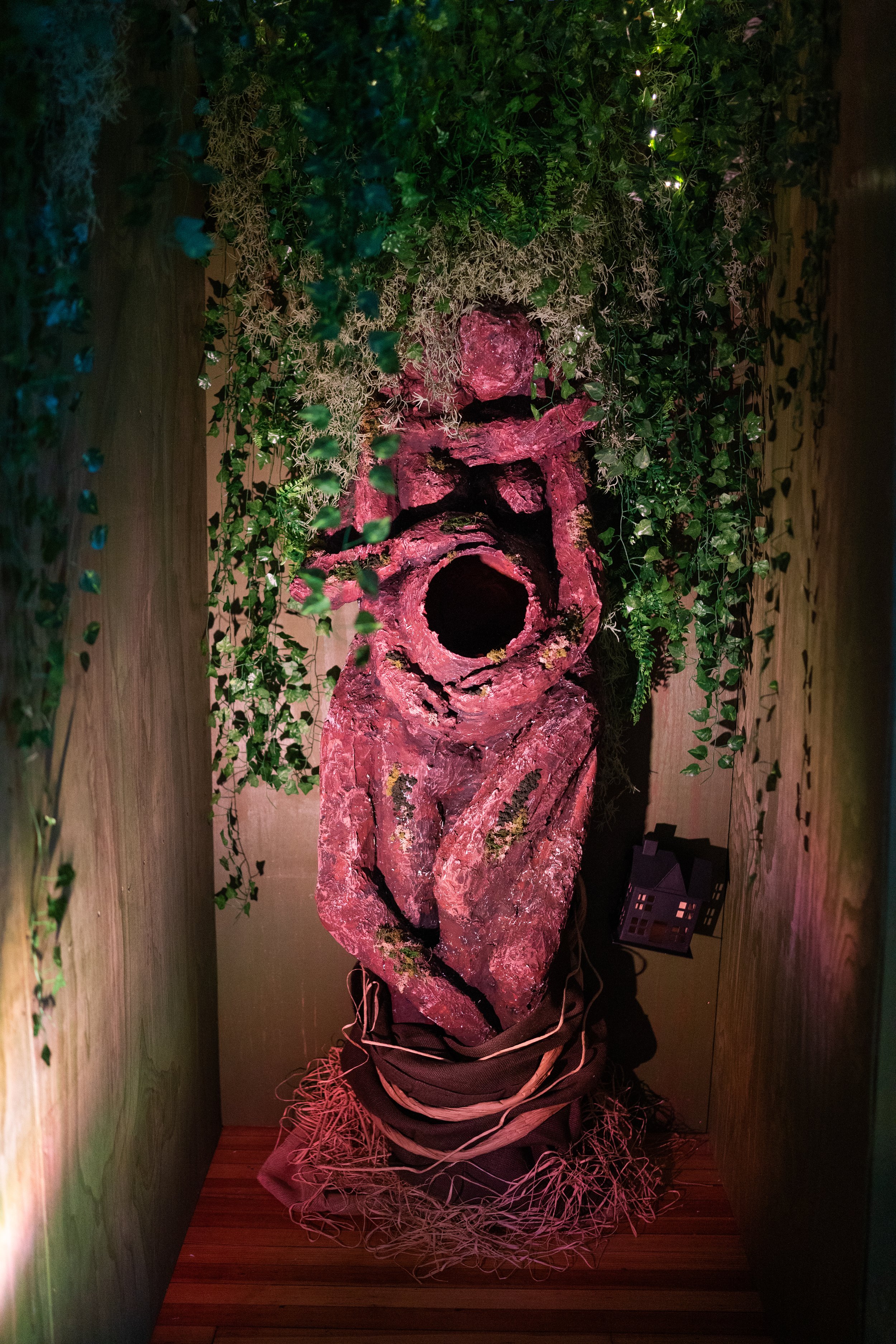
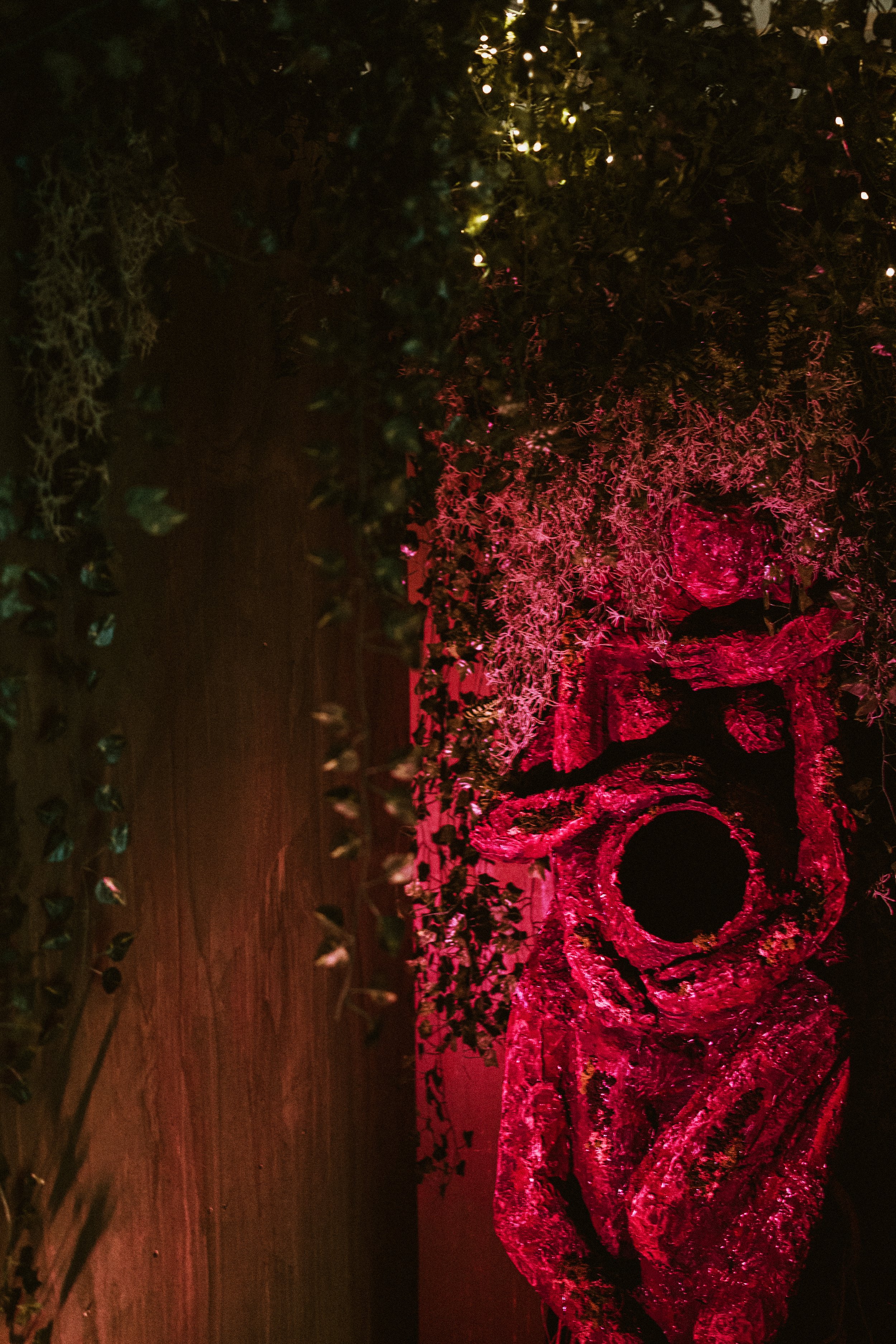

-
Sometimes the deeply surreal nature of grief firmly grounds us in reality; forces us to evaluate ourselves in ways we didn’t know we needed to - ways that define who we are and who we will be. When I found out I was pregnant with my first child, my biggest fear was that he would be grown in a womb full of grief and be born to a mother steeped in sadness. I had to make a choice, and his presence in my body forced me to directly face and make some peace with my pain and my fear. The timing of his conception seemed like a message, and his birth revealed to me the cyclical nature of existence. Simultaneously grieving my father while experiencing my firstborn son grow in my womb - who my father would never meet - opened a portal in both my body and my mind, showing me that our bodies are liminal vessels of existence but that our existence is infinite.
This room will have a tree growing out of the walls whose curviture and form resemble a woman tangled into other bodies, with an open womb in the center of this piece. Visitors will be encouraged to leave artifacts of their choosing in the womb - things they wish to grow their understanding of; things they wish to let go of or change.
ASTRAL
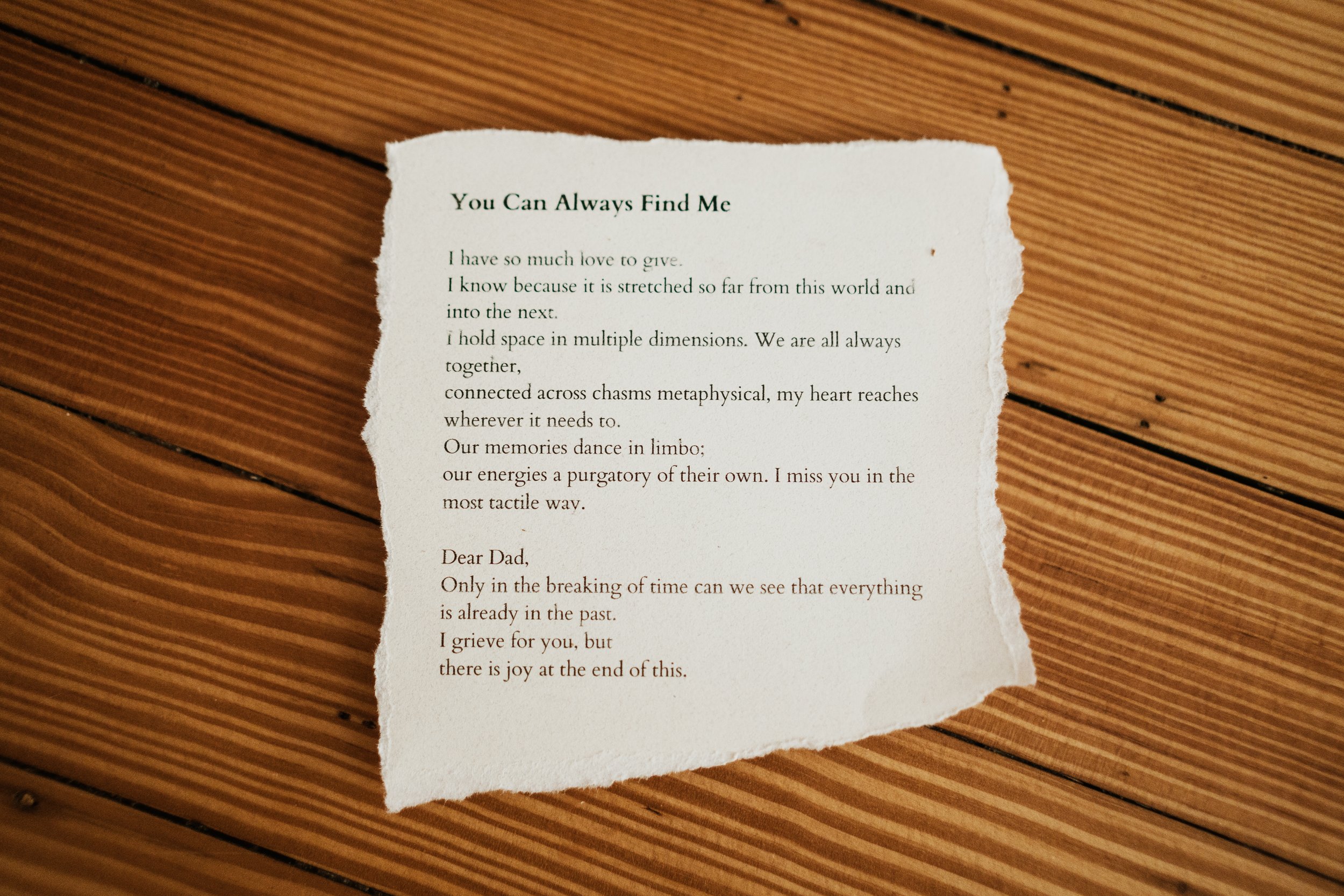
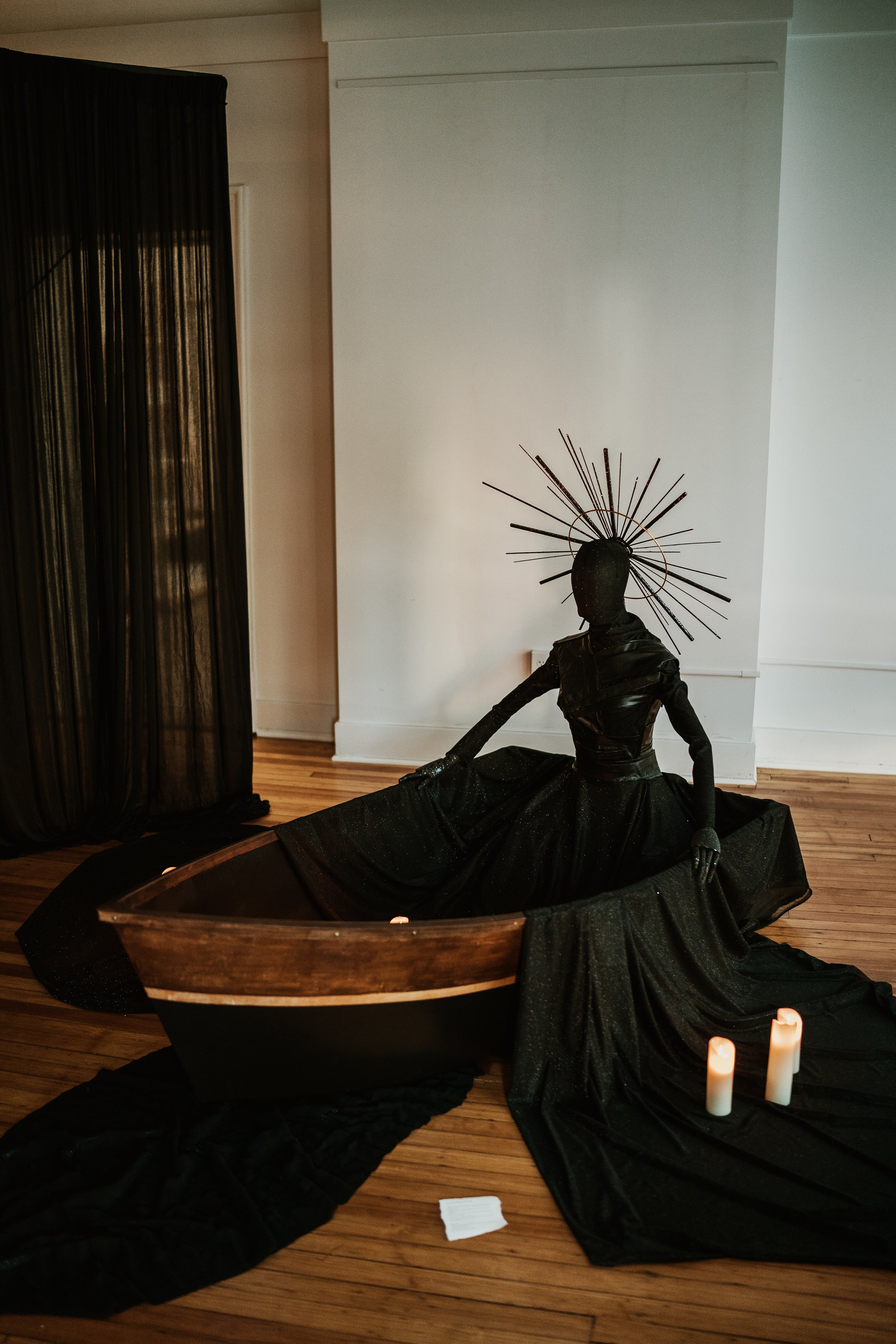
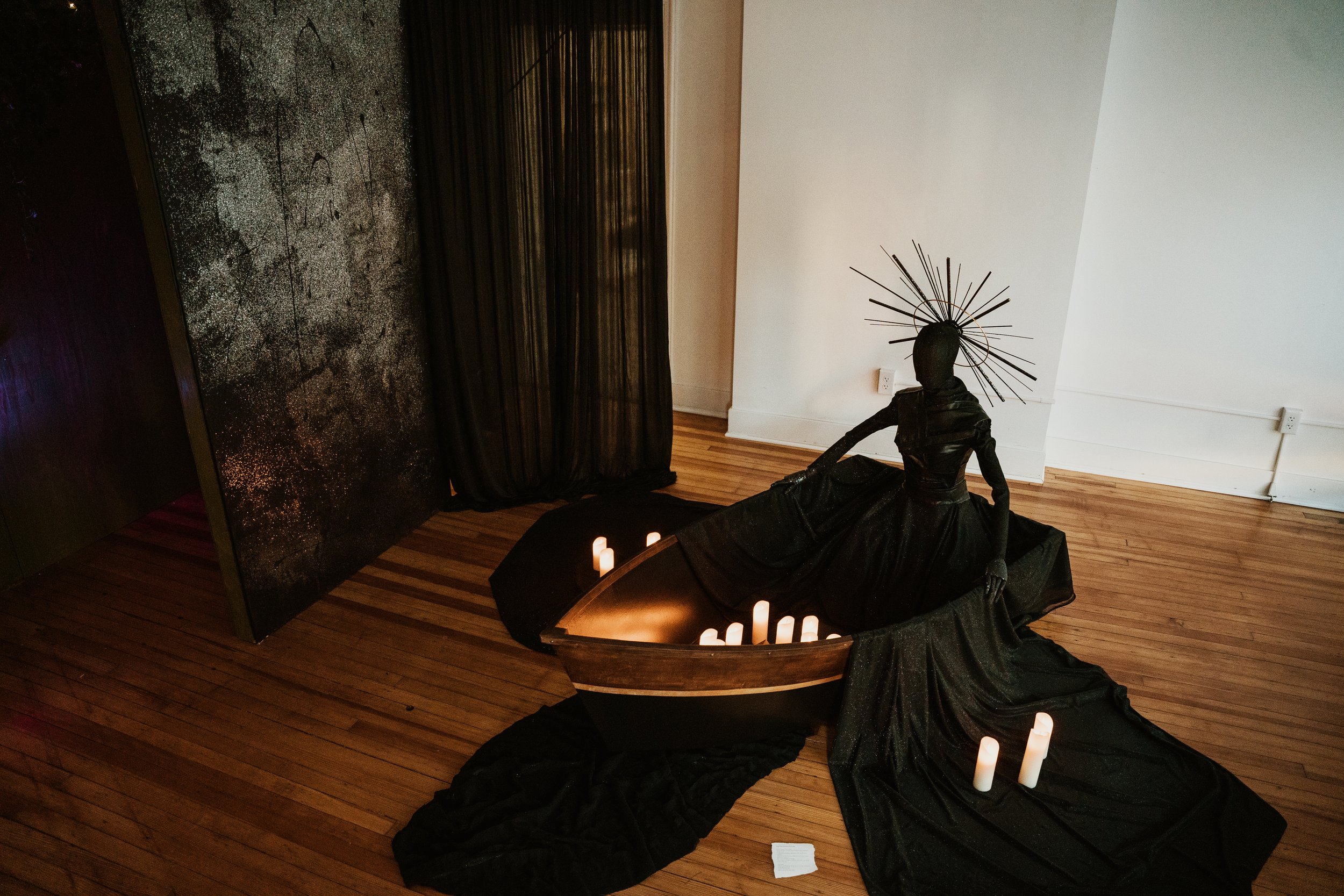
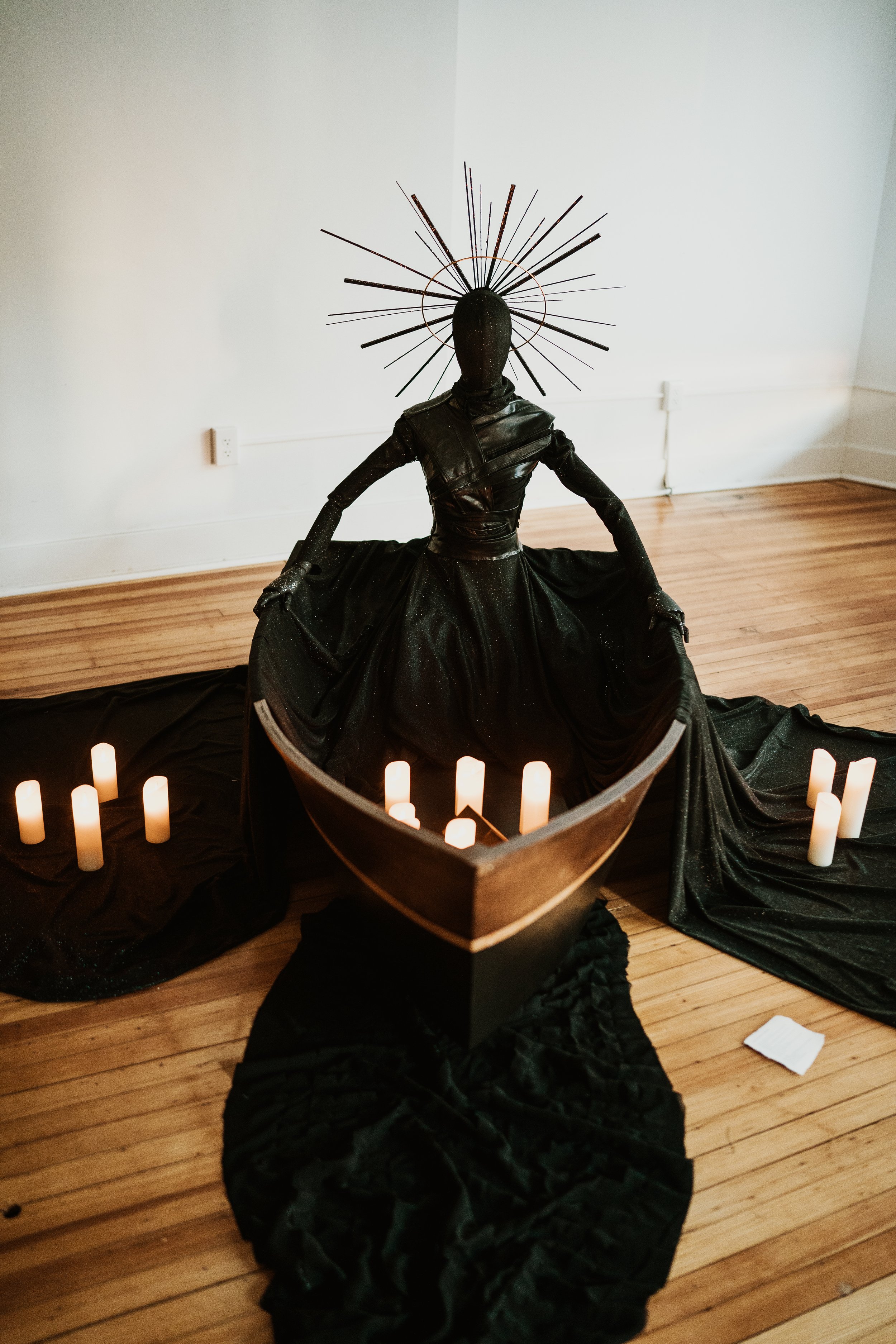
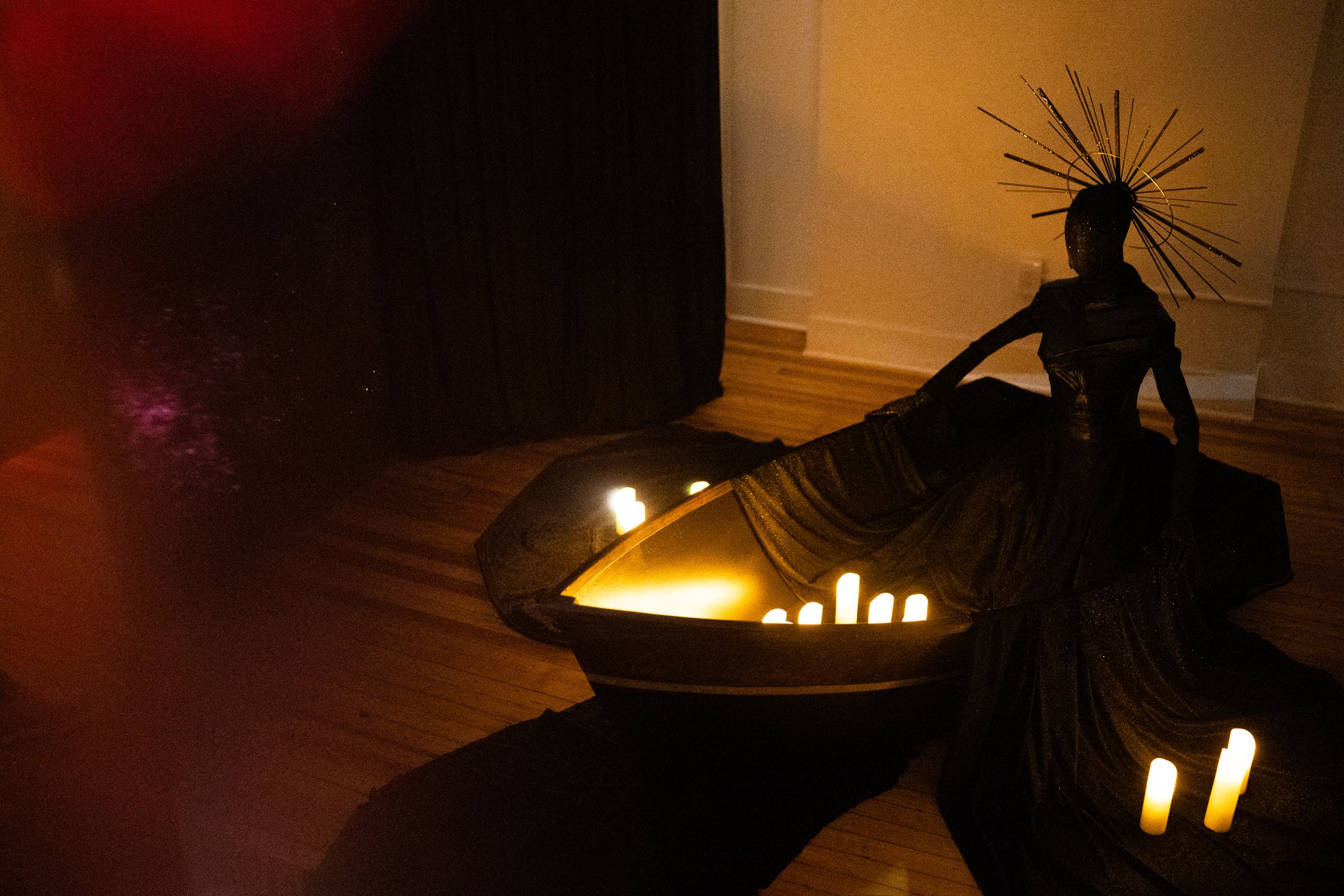
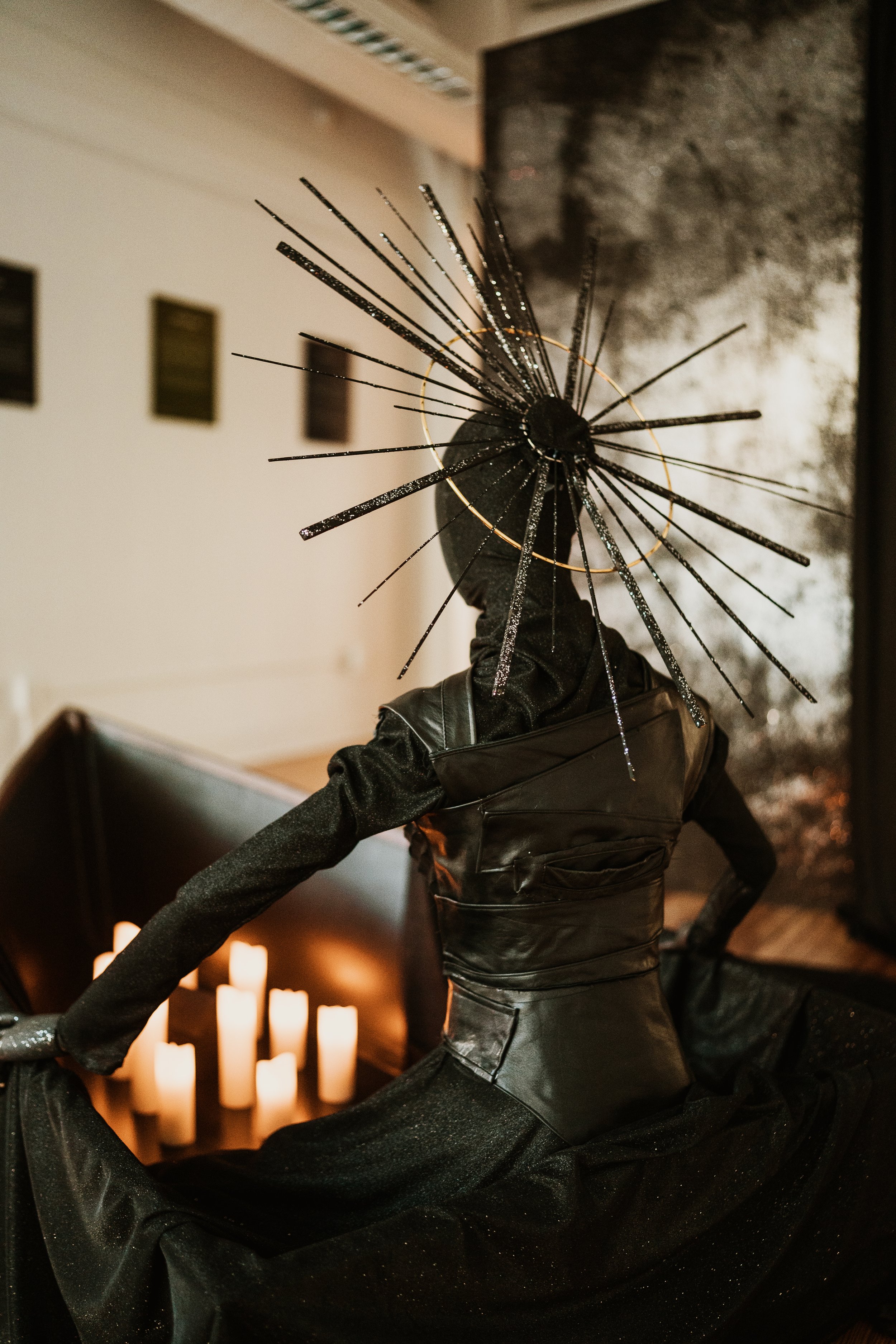
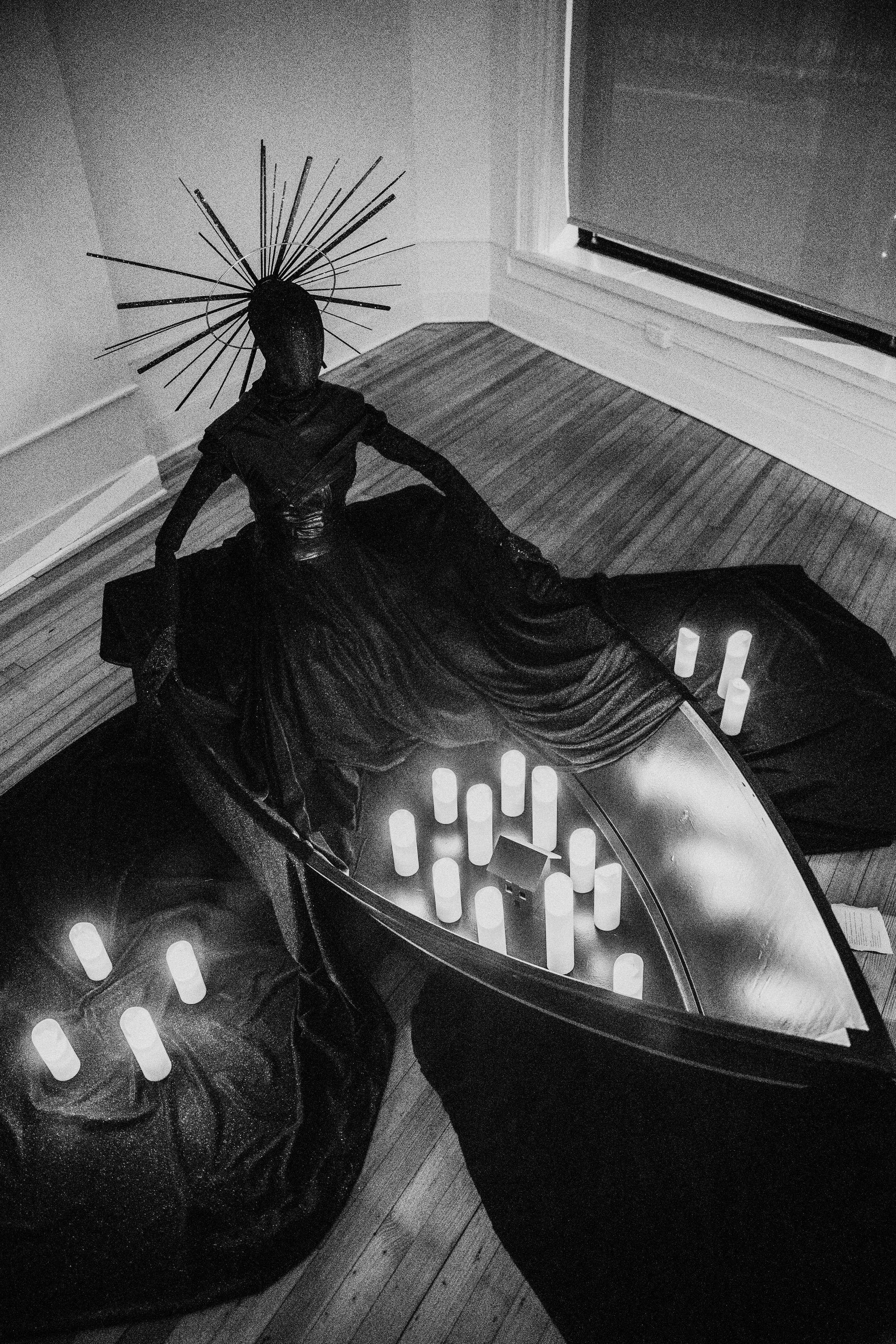
-
Our journey with grief is neverending, but our relationship to it can change and morph into something full of wisdom and growth. Though a nonreligious person, both my experience with and conclusions about grief are very spiritual. The experience of deep grieving brought me to a surreal space that asked me to grapple with enormous questions about the universe and existence - the heaviest of which being is there life after death, or is there nothing at all? And which makes me feel more uncomfortable?
The mannequin in this room will be seated in a row boat.
The row boat symbolizes multiple myths and cultural beliefs that our souls are ferried to the afterlife, and it will have an extra seat for visitors to sit in and contemplate.
The manneuqin’s garment will appear to supernaturally flow over the boat and onto a false floor that creates the starry ocean on which they are traveling - symbolizing the merging of the mannequin with space-time and the interconnectedness of existence.
Allowing visitors to contemplate their journey while seated admist the physical representation of a metaphysical journey creates an exit to the exhibit that allows for closure, healing, and hope.
GRATITUDE
AN ENORMOUS THANK YOU TO OUR SPONSORS AND DONORS, WITHOUT WHOM THIS EXHIBIT WOULD NOT BE POSSIBLE.
OUR GENEROUS DONORS: John Murphy • Deirdre Kane • Andrew Reese • Josh & Juliana Means • Matthew Filippelli • Safia Morsly-Fikai • Robin Hornstein • Colleen Kiel • Flavia Brunetti • Katy Broman • Stephanie Yecko Doak • Justin Joyce • Nicole Egri • Gary & Joanne Hertrich • Daniel Shaner • Emily Zarecki • Dave & Kris Filippelli • Kursten Bruderly • Diana Patton • Kiera & Ren Mathew • Casey Harvilla • Aly Sterling • Rachel Richardson • Mary Lou Blasko • Jackie Hamilton • The Newman Family • Celia Williamson • Brian Roscoe • Lisa Ocilka • Stephen Peisner • Dennis & Kathy Filippelli • Alese Gwinn • Erica Lynn • David Manko • Nicole Baldy


